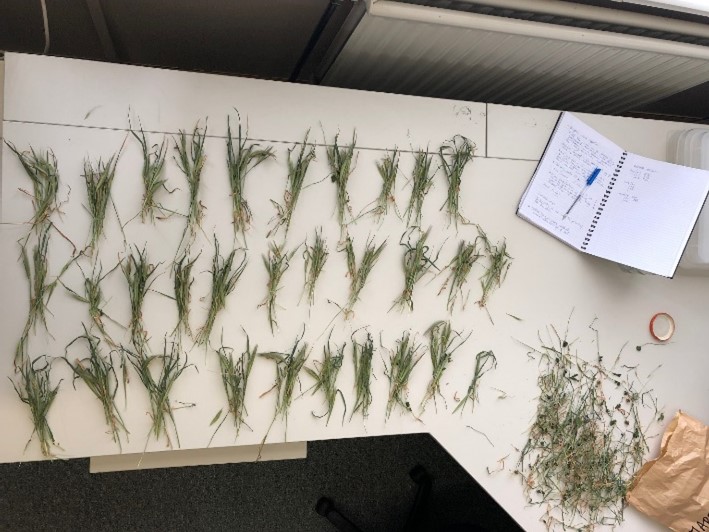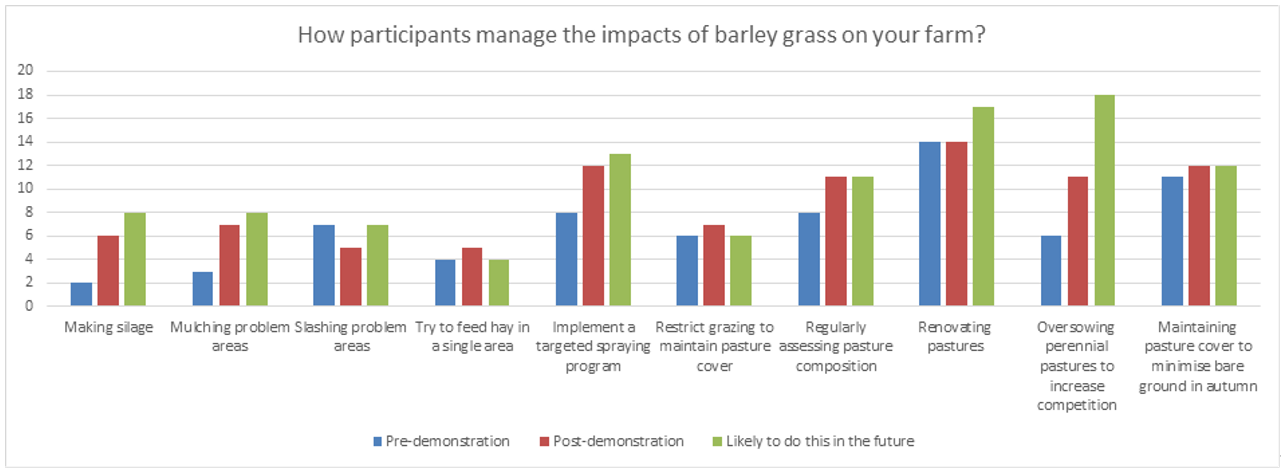Annual grass control in perennial pastures – Enhanced Producer Demonstration Site (PDS)
Download a printable version of this page: Barley grass control ![]() [PDF File - 207.9 KB]
[PDF File - 207.9 KB]
The incursion of annual weeds into pastures and a reduced number of herbicide options for their control prompted the Perennial Pasture Systems (PPS) group to look for a broader range of management techniques. PPS is largely based around Stawell and Ararat, with rainfall totals of 450-500mm per annum. Members predominantly run perennial pasture-based systems with sheep, both prime lamb and wool enterprises.
This demonstration began with a focus on annual grass weeds generally, however early in the project there was a shift in focus to barley grass control. Barley grass (Hordeum leporinum) continues to be an issue in pastures, especially after periods of dry conditions and where perennial pasture has thinned. Barley grass can have a huge impact on the ability of growers to turn off seed-free meat and wool, with producers incurring price downgrades to various extents. In addition to the price downgrades, there are significant animal health issues that arise from the sharp seeds.
The invasion of annual grasses also has a deleterious effect on desirable grasses, competing for light, nutrients and moisture.
Aim
The aim of the project was to reduce the reliance on chemical control of barley grass by investigating other options such as mechanical removal, increased competition, and grazing management.
The key objectives were to:
- To demonstrate the impact (both positive and negative) of various barley grass control strategies on total dry matter production and pasture composition in perennial pastures.
- To demonstrate a combination of options to reduce barley grass seed numbers across member sites.
- To increase the knowledge and skills of the PPS group regarding barley grass control in perennial pastures.
Methodology
Host producers were sought from PPS membership to trial seven different strategies in isolation or in combinationwith other strategies. These included sowing into existing pastures, using hard seeded legumes, chemical options, chemical resistance testing, hay making, silage making and grazing management. Trial sites were assessed for barley grass control by counting seedheads (Fig. 1), pasture composition assessments and dry matter assessments. Where possible multiple trial sites were used to assess each strategy.

Results and key findings
The seven strategies measured varying levels of success in controlling barely grass. Mechanical removal, increasing competition and chemical control in combination, was the most successful strategy for reducing barley grass during the project. A reduction in barley grass through competition alone was not achieved.
Mechanical removal through silage also reduced barley grass and provided the benefit of making the ensiled seed unviable.
Intensive grazing management was problematic to manage, requiring very high stock numbers, and did not measure a reduction in barley grass.
Chemicals used in isolation reduced barley grass, however the effects were not long lived, as a second germination occurred when conditions were favourable, such as after spring rain.
The main messages from the trials included:
- Barley grass is a prolific and adaptable plant (seedhead counts of up to 21 million/ ha were found during the project).
- For competition to be successful weed control must be considered in conjunction with oversowing.
- Mechanical removal of seedheads (silage and hay) can reduce populations in pasture in subsequent years.
- Ensiling makes barley grass seeds non-viable
- Grazing management to control barley grass seed set is difficult to manage due to the high numbers of stock and the intense grazing required in a normal farm situation.
- Late season rainfall will cause secondary germination which can reverse early season intervention.
Change in management
PPS members were asked to rate their management techniques for barley grass control before and after demonstration as well as their likely future strategies. Members indicated that their awareness and knowledge of using silage, late season slashing, mulching, chemical control and over sowing to control barley grass had increased throughout the project. They also indicated changes in the practices used to manage barley grass (Fig. 3) which reflected the successful results from the on-farm trials.

Benefits to industry
While the project has not found any new methods for controlling barley grass, it has increased the knowledge and skills of the large PPS producer group to better deal with barley grass.
The demonstration raised the awareness of the usefulness of barley grass in early spring, providing it is managed correctly when seedheads emerge.
This increased awareness of the barley grass lifecycle and control methods will assist producers in reducing the meat and wool seed contamination.
The project has successfully increased the awareness of making silage in the area which was successful at reducing barley grass. However, there is a barrier to the adoption of this technique due to the cost of purchasing specialist equipment, availability of contractors and the topography in the region.
More information
Rob Shea
PPS Project Manager
Yadin061@tpg.com.au
Tess McDougall
Agriculture Victoria
tess.mcdougall@agriculture.vic.gov.au